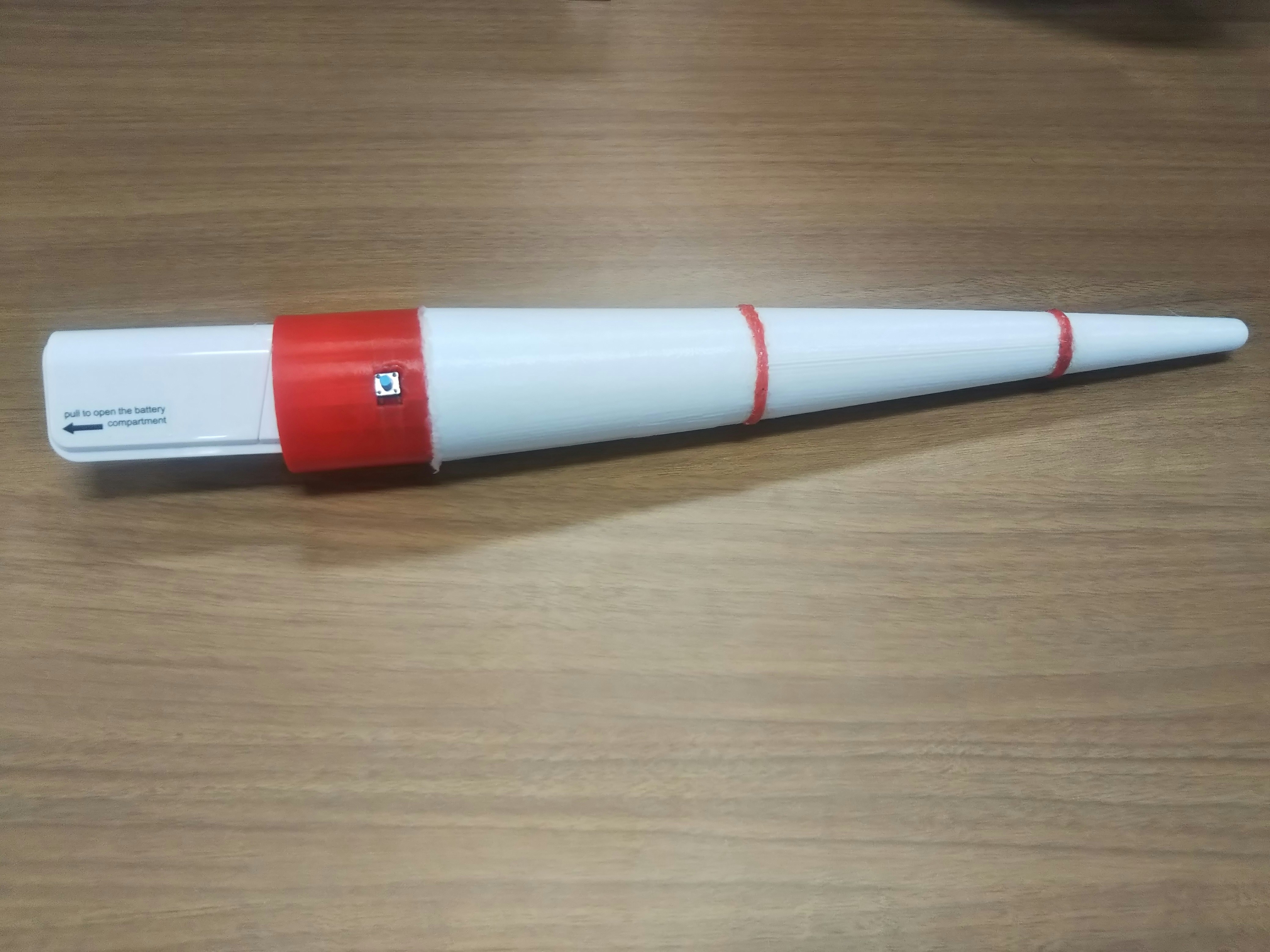Wiiのようなジェスチャーゲームを作っていたので、そこで学んだことを記述していきたいと思います。
こちらが魔法の杖!

外装は3Dプリンタで作成。
中にはESPと加速度センサが入っている。
スイッチは外から押せるようにした。
100円ショップのモバイルバッテリーとESPを接続。
魔法の杖から加速度を取得する
こちらは「スイッチを押しているとき、加速度の値をBluetoothで送信する」からコードを少し変えています。
変更点はこちら
- スイッチを押しているときではなく、常に加速度の値を送信しています。
- スイッチを押した瞬間、押されたという情報を送信します。
# include <SparkFunLSM9DS1.h>
# include "BluetoothSerial.h"
# define LSM9DS1_M 0x1E
# define LSM9DS1_AG 0x6B
# define SW_PIN 7 //pin番号を指定する
LSM9DS1 imu;
BluetoothSerial SerialBT;
int sw_before = 0;
uint16_t connectionState = 0;
void setup()
{
Serial.begin(115200);
SerialBT.begin("ESP32"); //Bluetooth接続で表示される名前を指定
pinMode(SW_PIN, INPUT);
imu.settings.device.commInterface = IMU_MODE_I2C;
imu.settings.device.mAddress = LSM9DS1_M;
imu.settings.device.agAddress = LSM9DS1_AG;
if (connectionState == 0)
{
connectionState = imu.begin();
while (connectionState == 0)
{
Serial.println("Failed to communicate with LSM9DS1.");
Serial.println("Double-check wiring.");
Serial.println("Default settings in this sketch will "
"work for an out of the box LSM9DS1 "
"Breakout, but may need to be modified "
"if the board jumpers are.");
Serial.print("Connection Status: ");
Serial.println(imu.begin());
delay(1000);
connectionState = imu.begin();
Serial.println("------------------------------------------------------\n");
}if(connectionState!=1){
Serial.print("connectionState: ");
Serial.println(connectionState);
}
}
}
void loop()
{
float x, y, z;
imu.readAccel();
x = imu.calcAccel(imu.ax)*10;
y = imu.calcAccel(imu.ay)*10;
z = imu.calcAccel(imu.az)*10;
int sw_state = digitalRead(SW_PIN); // スイッチが押されてるとき1、押されていないと0
if(sw_state == 1 && sw_before == 0){ // 0だったのが1に切り替わった
SerialBT.println("clicked");
}else{
SerialBT.println("no");
}
SerialBT.println(x);
SerialBT.println(y);
SerialBT.println(z);
sw_before = sw_state;
delay(20);
}
ジェスチャーの予測モデルを作成
PCで加速度を受信し、ジェスチャの予測モデルを作成します。
Bluetoothを接続
ESP側を動かしたままで、PC本体の、
"設定→デバイス→Bluetoothとその他のデバイス→Bluetoothまたはその他のデバイスを追加する→Bluetooth"
の順で探し、自信で指定したESPのデバイス名(今回の場合はESP32_2)をクリック。接続が終わったら完了。
COMポートを探す
そのまま、PC本体の、
"設定→デバイス→Bluetoothとその他のデバイス→その他のBluetoothオプション→COMポート
で、接続されたESPの"発信"側のポート番号をコピー。
コード
上記のポート番号を、12行目の
ser = serial.Serial(.......
の "COM??" に入力する。
今回は3種類のジェスチャーを3回ずつ行い、入力した名前の予測モデルを作成するコードです。ゲームのチューニング程度なので3回にしましたが、ジェスチャーの種類の数と回数、長さ等は仕様に応じて変更してください。
# coding utf-8
import serial #シリアル通信を行うため
import numpy as np #numpyで2次元配列を扱うため
from sklearn.svm import SVC #学習用
import pickle #モデルをファイルとして使用する用
length = 20 #ジェスチャの長さ(連続で受信するデータの個数)
gestures = 3 #ジェスチャの種類の数
times = 3 #各ジェスチャを行う回数
print('Connecting...')
ser = serial.Serial('COM19',115200,timeout=None) #ポート番号19からシリアル受信
print('Input your name:')
name = input()
filename = 'model_' + name + '.sav' #入力した名前の学習モデルのファイル名
X = []
Y = []
for i in range(gestures * times):
cnt = 0 #受信したデータのカウント用
mx = [] #各軸ごとの配列を初期化
my = []
mz = []
gesture_num = i % gestures + 1 #ジェスチャ番号を指定
print('Do gesture No.', gesture_num)
while True:
line = ser.readline() #シリアルから1行取得
switch = line.decode('utf-8') #コード変換
line = ser.readline()
x = line.decode('utf-8')
line = ser.readline()
y = line.decode('utf-8')
line = ser.readline()
z = line.decode('utf-8')
if switch == 'clicked\r\n' and cnt == 0: #クリックされたらカウント開始
cnt = 1
if cnt != 0: #ジェスチャ中
mx.append(x.rstrip('\r\n')) #シリアルから受け取ってたデータのゴミを取って配列へ追加
my.append(y.rstrip('\r\n'))
mz.append(z.rstrip('\r\n'))
cnt += 1
if cnt == length: #lengthまでいったら次のジェスチャ待ちへ
break
m = mx + my + mz #三軸の加速度を横一列にする
X.append(m) #学習データ用リストへ追加
Y.append(str(gesture_num)) #学習ラベル用リストへ追加
ser.close() #シリアルを閉じる
model = SVC(kernel = 'linear', C=1, gamma=1) #学習モデルのパラメータを指定
model.fit(X,np.ravel(Y)) #学習を行う
with open(filename, 'wb') as fp_model: #学習モデルを保存するためのファイルを開く
pickle.dump(model, fp_model) #モデルを保存
print('Model created.')
これで予測モデルが保存されました!
研究目的ではありませんので、精度検証は行わず早速ジェスチャーを判定してみましょう。
ジェスチャーを判定し続ける
PCで加速度を受信し、ジェスチャーを判定し続けます。
以下のプログラムで、ポート番号を適切に変えて実行するだけです。
import serial #シリアル通信を行うため
import pickle #モデルをファイルとして使用する用
length = 20 #ジェスチャの長さ(連続で受信するデータの個数)
print('Connecting...')
ser = serial.Serial('COM19',115200,timeout=None) #ポート番号19からシリアル受信
print('Input your name:')
name = input()
filename = 'models/model_' + name + '.sav' #入力した名前の学習モデルのファイル名
print('Loading...')
with open(filename, 'rb') as fp_model: #学習モデルファイルを開く
loaded_model = pickle.load(fp_model) #モデルをロード
print('Do any gesture!')
try:
while True:
cnt = 0 #受信したデータのカウント用
mx = [] #各軸ごとの配列を初期化
my = []
mz = []
while True:
line = ser.readline() #シリアルから1行取得
switch = line.decode('utf-8') #コード変換
line = ser.readline()
x = line.decode('utf-8')
line = ser.readline()
y = line.decode('utf-8')
line = ser.readline()
z = line.decode('utf-8')
if switch == 'clicked\r\n' and cnt == 0: #クリックされたらカウント開始
cnt = 1
if cnt != 0: #ジェスチャ中
mx.append(x.rstrip('\r\n')) #シリアルから受け取ってたデータのゴミを取って配列へ追加
my.append(y.rstrip('\r\n'))
mz.append(z.rstrip('\r\n'))
cnt += 1
if cnt == length: #lengthまでいったら次のジェスチャ待ちへ
break
m = mx + my + mz #三軸の加速度を横一列にする
m2 = [] #リスト型にするため
m2.append(m) #リストへ追加
pre = loaded_model.predict(m2) #ジェスチャの判定
print('This gesture is No.', pre[0][0])
except KeyboardInterrupt: # Ctrl-C を捕まえたら終了
print('Close!')
ser.close() #シリアルを閉じる
できましたでしょうか?
ゲームで応用する場合は、判定したものをソケット通信で送信し、Unity側のC#で受け取れば実装できます。処理もなかなか素早くできますよ。
ご不明点等あればお気軽に質問してください。